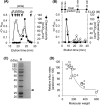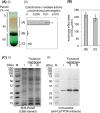Thylakoid membranes contain a non-selective channel permeable to small organic molecules
- PMID: 29602906
- PMCID: PMC5961035
- DOI: 10.1074/jbc.RA118.002367
Thylakoid membranes contain a non-selective channel permeable to small organic molecules
Abstract
The thylakoid lumen is a membrane-enclosed aqueous compartment. Growing evidence indicates that the thylakoid lumen is not only a sink for protons and inorganic ions translocated during photosynthetic reactions but also a place for metabolic activities, e.g. proteolysis of photodamaged proteins, to sustain efficient photosynthesis. However, the mechanism whereby organic molecules move across the thylakoid membranes to sustain these lumenal activities is not well understood. In a recent study of Cyanophora paradoxa chloroplasts (muroplasts), we fortuitously detected a conspicuous diffusion channel activity in the thylakoid membranes. Here, using proteoliposomes reconstituted with the thylakoid membranes from muroplasts and from two other phylogenetically distinct organisms, cyanobacterium Synechocystis sp. PCC 6803 and spinach, we demonstrated the existence of nonselective channels large enough for enabling permeation of small organic compounds (e.g. carbohydrates and amino acids with Mr < 1500) in the thylakoid membranes. Moreover, we purified, identified, and characterized a muroplast channel named here CpTPOR. Osmotic swelling experiments revealed that CpTPOR forms a nonselective pore with an estimated radius of ∼1.3 nm. A lipid bilayer experiment showed variable-conductance channel activity with a typical single-channel conductance of 1.8 nS in 1 m KCl with infrequent closing transitions. The CpTPOR amino acid sequence was moderately similar to that of a voltage-dependent anion-selective channel of the mitochondrial outer membrane, although CpTPOR exhibited no obvious selectivity for anions and no voltage-dependent gating. We propose that transmembrane diffusion pathways are ubiquitous in the thylakoid membranes, presumably enabling rapid transfer of various metabolites between the lumen and stroma.
Keywords: CpTPOR; chloroplast; cyanobacteria; diffusion channel; liposome; membrane transport; muroplast; permeability; photosynthesis; porin; thylakoid membrane.
© 2018 Kojima et al.
Conflict of interest statement
The authors declare that they have no conflicts of interest with the contents of this article
Figures






Similar articles
-
Outer Membrane Permeability of Cyanobacterium Synechocystis sp. Strain PCC 6803: Studies of Passive Diffusion of Small Organic Nutrients Reveal the Absence of Classical Porins and Intrinsically Low Permeability.J Bacteriol. 2017 Sep 5;199(19):e00371-17. doi: 10.1128/JB.00371-17. Print 2017 Oct 1. J Bacteriol. 2017. PMID: 28696278 Free PMC article.
-
Assessment of the requirement for aquaporins in the thylakoid membrane of plant chloroplasts to sustain photosynthetic water oxidation.FEBS Lett. 2013 Jul 11;587(14):2083-9. doi: 10.1016/j.febslet.2013.05.046. Epub 2013 May 31. FEBS Lett. 2013. PMID: 23732702 Review.
-
Evidence for nucleotide-dependent processes in the thylakoid lumen of plant chloroplasts--an update.FEBS Lett. 2012 Aug 31;586(18):2946-54. doi: 10.1016/j.febslet.2012.07.005. Epub 2012 Jul 13. FEBS Lett. 2012. PMID: 22796491 Review.
-
Function and evolution of channels and transporters in photosynthetic membranes.Cell Mol Life Sci. 2014 Mar;71(6):979-98. doi: 10.1007/s00018-013-1412-3. Epub 2013 Jul 9. Cell Mol Life Sci. 2014. PMID: 23835835 Free PMC article. Review.
-
The ten amino acids of the oxygen-evolving enhancer of tobacco is sufficient as the peptide residues for protein transport to the chloroplast thylakoid.Plant Mol Biol. 2021 Mar;105(4-5):513-523. doi: 10.1007/s11103-020-01106-8. Epub 2021 Jan 3. Plant Mol Biol. 2021. PMID: 33393067 Free PMC article.
Cited by
-
The Need for Consistency with Physical Laws and Logic in Choosing Between Competing Molecular Mechanisms in Biological Processes: A Case Study in Modeling ATP Synthesis.Function (Oxf). 2022 Oct 14;3(6):zqac054. doi: 10.1093/function/zqac054. eCollection 2022. Function (Oxf). 2022. PMID: 36340246 Free PMC article. Review.
-
Myelin sheath and cyanobacterial thylakoids as concentric multilamellar structures with similar bioenergetic properties.Open Biol. 2021 Dec;11(12):210177. doi: 10.1098/rsob.210177. Epub 2021 Dec 15. Open Biol. 2021. PMID: 34905702 Free PMC article.
References
Publication types
MeSH terms
Substances
LinkOut - more resources
Full Text Sources
Other Literature Sources
Miscellaneous

